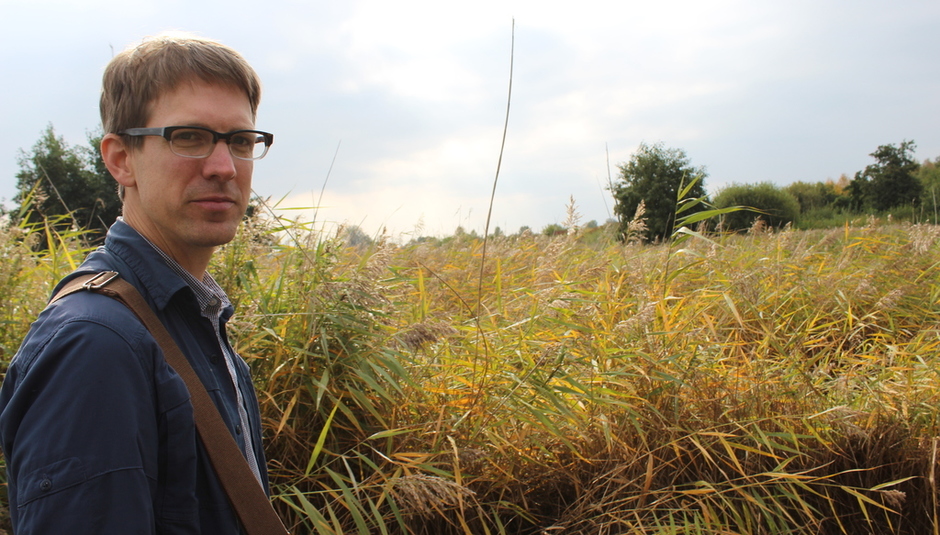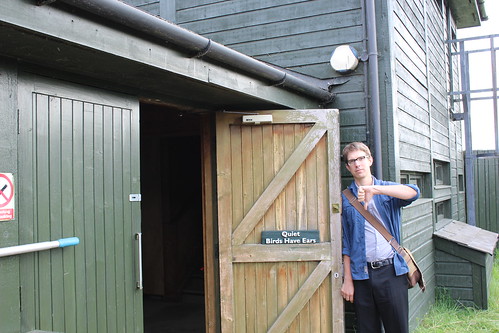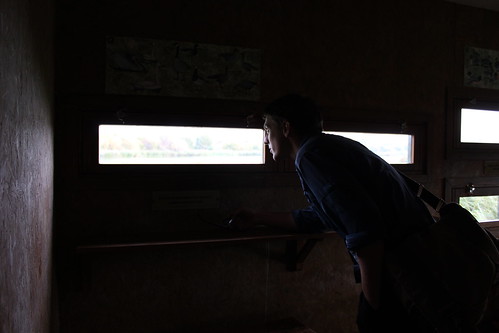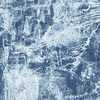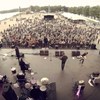‘William Henry Hudson met T.E. Lawrence, actually; in 1922 they sat for a portrait at the same time. The same painter’s studio. And they had a long conversation, Hudson wrote, about science versus art…’
I’m sat next to Jonathan Meiburg, formerly of Okkervil River, now of Shearwater, on a bench in the middle of the London Wetland Centre in Barnes. I’ve brought him here because of his reputation for being American music’s Birdman, a musician-cum-ornithologist whose work in both fields once resulted in songs that made sense of the relationship between the human animal and the natural world with avian metaphors and actualities and tremulous, exquisitely hollow-boned songwriting. It quickly becomes apparent that this isn’t where he’s at now, that he’s bored of this whole bird thing, and yet my decision to frame an interview in this way is totally fair enough: ‘You don’t want to be the guy who wrote a bunch of songs about birds. And honestly, birds haven’t made that many appearances in my songs. But I asked for it by talking about them a lot – like I am now.’
He has been talking about birds quite a bit, mostly with my birder little brother David who I brought along with me to lace my questions with expert vocab. Primarily he’s talked about the book he’s writing, about the story of a delightful species native to the Falklands that the islanders call the Johnny Rook, and everyone else calls the striated caracara. Described by Darwin as ‘tame and mischievous, quarrelsome and passionate’, it has become the focal point of all Jonathan’s aviphilia: ‘where the book starts is a place I just was in, in South Devon, it’s called Woodlands Family Theme Park. And there’s a little falconry centre there, where a man called Jeff Pearson had a striated caracara called Tina. She could do the most incredible things. He would throw a set of stuffed animals onto the ground after holding them up in front of her and naming them, and then he would call out a name and she would go and retrieve it.
‘Tina actually died last year, she had to be put down. Jeff is still quite broken up about her being gone, they were really friends. The book asks two questions really: how did Jeff and Tina get to be friends, and why is Tina so different to all the other birds that he has in his collection? It tries to answer those questions on a really grand scale, using the ten living species of caracara to explain the story of the whole South American continent and why it’s like it is now.’
South America is where Hudson, the Anglo-Argentine co-founder of the RSPB, enters the story. And Hudson is important because as well as representing an energy that inhabits a lot of Shearwater’s songs – ‘a funny difference between Hudson and Darwin is that I don’t think Darwin ever really wanted to be an animal, whereas Hudson would have been quite happy to have been a crested screamer’ – his meeting with Lawrence of Arabia is a neat symbolic intersection between Jonathan’s work on his book and the new Shearwater album, released on 22 January. The title of its closing track ‘Stray Light at Clouds Hill’ is a reference to Lawrence’s little cottage in Dorset (presumably Jonathan discovered it on his way to the Woodlands Family Theme Park) and the figure of Lawrence provides, in what I guess is a sort of dramatic monologue, the album with its final image – of striving to live a life of synchronicity with the majesty of the natural world, rather than the misery of modernity: ‘I skimmed on the oceans, alone / And only see outlines … The light is so bright / The dark is so dark’.
What is it about Lawrence that caught Meiburg’s magpie eye? ‘Lawrence is interesting to me because he had gone out and sort of achieved this boyhood dream of recreating a scene from the crusades, shaping the world, and then he came back to all this fame and found he hated it. In some ways he spent the rest of his life in a retreat from that, you might even say a penance. That’s the poignancy of his life, and this cottage is a beautiful place. Mostly it’s just very small, a place where you would listen to records in the quiet with a few friends, and sit by yourself by a little fire for a long time. And that’s not what you’d expect of someone that you’d think of as emblematic of the last glory of the British imperial ambition.’
This is a typically Meiburgian entry-point into the wider narrative of the new album, Jet Plane & Oxbow. The relationship between text, anecdote and broader message isn’t at all clear here, when it’s first presented – in a manner that resembles Lawrence’s Seven Pillars of Wisdom, actually. And yet both the lyrics and the story they tell are so concrete and precise, so evidently chosen with great care, that we look again, and again, and eventually realise that everything does actually fit together, it’s just that the meaning of the work resides at an deep, elaborate and strange level that defies easy characterisation.
Let’s backtrack a little. ‘I think of this album honestly as a protest record,’ Jonathan suggests, early on. Protesting against what, though? ‘I was reading a thing where Bowie was talking about Scary Monsters and he was saying that he thought it was social protest music. And going back and listening to that record in that context, I was like, whoah, this is how you do a protest record, because you usually think of protest music and start rolling your eyes … The United States has so much going for it, but at the same time it has so much going against it, which is self-generated. And a lot of this record is about certain ideas that I feel like we grow up with, about the country and about who we ought to be within and outside the country.’
And suddenly Lawrence’s place at the end of the record makes sense: as the emblem of British imperial ambition who ducked out of the world he’d helped create by living a quiet life in Dorset, in a form of social protest. It’s not difficult to characterise Jonathan’s tendency to fly to the Falklands or Tierra del Fuego once he’s finished a tour, to look at caracaras for a few weeks, in similar terms. His own country is the USA, of course, so I ask him whether the example of Lawrence is an exception, and the energy of the rest of the album is mostly anti-American – or whether it’s a more general protest against the way in which one’s upbringing forms shackles one in ways we find difficult to question. He leans towards the latter: ‘maybe it’s just a getting older thing, you start seeing yourself in context more. That your life has been shaped by forces much larger than you. And when you become aware of [those forces] you can become very uncomfortable, especially when they are things that have been handed to you as comfort food for a very long time.’
That reference to comfort food strikes me as pretty America-targetting, though, as do the lyrics of the album’s first single,‘Quiet Americans': ‘Take the memories out, hide the evidence under / Piss on the world below / Like a dog that knows its name / Where are the Americans?’ Either way, all ambiguity falls away when you consider the music. Because Jet Plane & Oxbow is, musically speaking, by some margin Meiburg’s most direct album to date – even more so than 2012’s Animal Joy which was memorably described by Pitchfork as Shearwater ‘taking their best shot at meeting new listeners halfway’.
But it’s a directness rooted in the particular tropes of an unlikely clutch of artists: Scary Monsters-era Bowie, sure, but also Genesis, Peter Gabriel, even U2. We ask Jonathan why his reference points are so, like, naff this time round, and he celebrates the question with a little fist pump: ‘yes! But in a particular way, that dates from a particular time. One thing that we kept thinking about the record was that we wanted to place it in about 1980, right around the time digital was new in recording, before MIDI had taken over and made everything sound more robotic and really crispy. Those early digital devices are amazing: they have a sort of giddiness about them, they do really strange things, they’re unpredictable, they break a lot. And they make really big round sounds and you get a sense of the engineers who were working on them expanding into a new realm of things that were possible. So we wanted to harness some of that energy in it. I wanted to straddle that divide between then and the newer technological world that was coming.’
He mentions PiL’s Metal Box and Remain in Light by Talking Heads and Peter Gabriel 3 as touchstone albums that came out in 1980, too. When I ask about this project in the context of the neverending 80s revival in alternative music, he rightly points out that ‘it mostly didn’t seem to reach back to this particular time that we were thinking about.’ We talk about the role played by Brian Reitzell, the film composer who helped finish off some of the songs on Jet Plane & Oxbow, and it quickly becomes apparent that Jonathan approaches production and equipment with a birdwatcher’s obsessiveness: ‘[thanks to Bryan] we were able to run tracks through some of these classic weird pieces of audio gear, like the Publison Infernal Machine – early digital reverb that sounds great. And a thing called the Cyclosonic Songbird, which is what Pink Floyd used on The Final Cut to make the rockets go over your head.’
But it’s only when we ask why – why do all this to re-make the sound of 1980? – that everything suddenly fits together, like I knew it would. ‘I think there’s a connection you can draw with our time right now,’ Jonathan explains, ‘because technology seemed poised to change things in a way that might make life almost unrecognisable. [Like now] there was a sense of possibility and menace at the same time.’ In other words, Jet Plane & Oxbow might sound like Shearwater doing anthems but it’s actually another concept album every bit as elaborate and serious as the Island Arc trilogy: 11 tracks that ask questions about the place of human beings in their little worlds, and the wider world more generally; which make the case for extricating oneself from these patterns of existence as a form of social protest; and that do so in a musical language rooted in a time when opportunities to ask and extricate resembled those of present moment – and those opportunities literally resonated in the gear musicians and producers were using.
As we wander around the jolly walkways of the Wetland Centre, David pointing out harlequin ducks, Jonathan showing us videos of caracaras stealing from rucksacks from his last trip to the Falklands, I can’t help but feel like there’s a connection between the story he’s trying to tell about birds in South America and their place in the world, and the music he’s made about humans in America and their place in the world, which I’m struggling to articulate. Then suddenly he refers to the ‘remarkable consciousness’ of striated caracaras, and David and I turn round and are like, wait, what?
This, it turns out, is the true origin of Jonathan’s caracara obsession: the fact these eccentric birds seem to display a consciousness a little like our own. And, moreover: ‘the avian forebrain, it’s been really studied in birds like crows and parrots and it’s derived from a different structure within the brain than ours is. They evolved a forebrain that does a lot of the same things that ours does, from a completely different place. There’s a convergent consciousness, so convergent that we’re actually able to have conversations in English with parrots. It’s incredible!’
It’s this phenomenon that, on the one hand, encourages him to tell the story of South America through its birds (‘focussing in on this certain group of organisms allows you to see the whole world differently’) and on the other discourages him from writing the protest album many might have assumed would be his top priority – addressing the ecological catastrophe human beings are inflicting on the earth. The damage we’re doing to the habitats of our fellow creatures is a tragedy, certainly, but he can’t help but feel pretty fatalistic about it all: ‘David Brower of Friends of the Earth used to like to tell people that if you compress the entire history of the earth into a week, the dinosaurs appear at 4pm on the last day. The world has been many different ways from how it is now, it’s had its clock cleaned multiple times. This version of the world will pass away, and it will be replaced by something else.’
His music will pass away too, of course. With a wry smile, he sings some lines from a song by Mount Eerie: ‘these rocks don’t care if I live or die / everyone I know will finally turn away / I will confuse and disinterest all posterity / lost wisdom’. But if that’s the case, where does it leave art? Why bother protesting, or doing anything at all for that matter, in this pointless animal world?
Because it can help us live better, he suggests: ‘what makes music interesting is its ability to evoke truths about the world in all of its contradiction, all of its beauty, all of its ugliness.’ And if we’re not living better then we’re not living at all: ‘this is something Hudson writes about, that for him seeing a bird stuffed in a museum cabinet was not seeing a bird. He said, there’s no such thing as a dead bird. Only the living animal is itself.’
With David Kinchin-Smith. All photographs by Sam Kinchin-Smith. Thanks to the London Wetland Centre.

